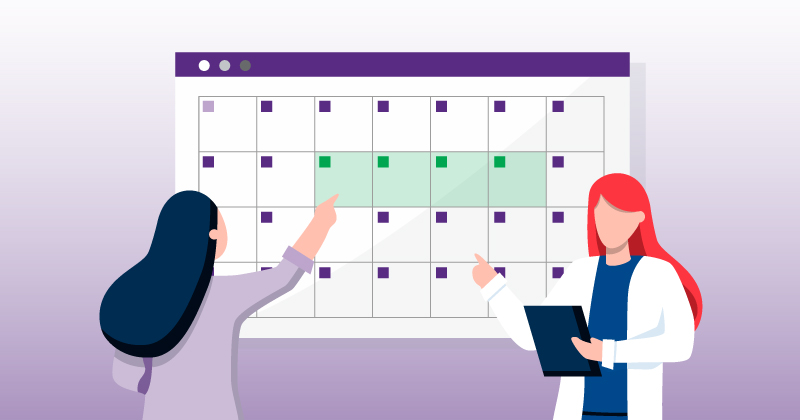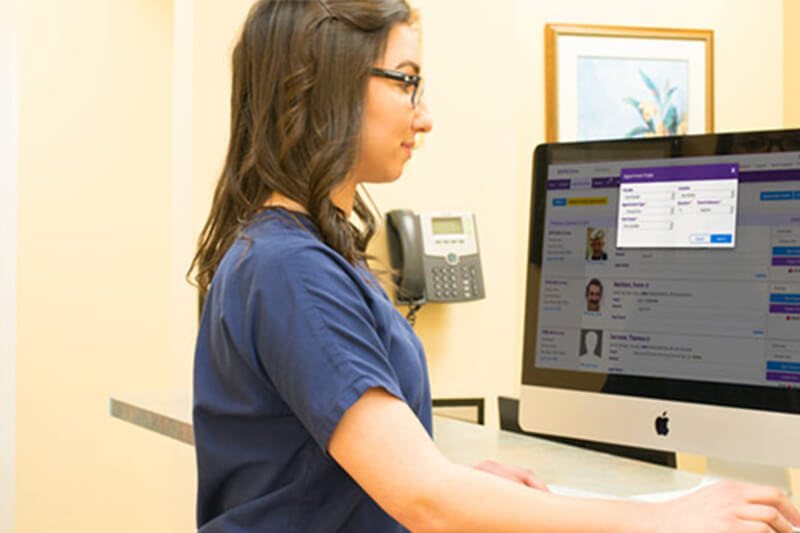Helping to Maximize Your Schedule With Plastic Surgery Software

Knowing best practices when working towards optimizing your patient schedule can pay off in huge ways.
Maximizing your schedule as a plastic surgeon can be much easier nowadays with the help of dynamic technology. Plastic surgery electronic health record (EHR) software has come a long way, and some industry-leading EHR vendors are catering to the specific needs of plastic surgeons.
Added tools within the EHR interface such as analytics, practice management and MIPS tracking and reporting can help to simplify the workday, so your staff can focus more on scheduling processes.
Every busy plastic surgeon knows the value of an efficient practice and see how maximizing your patient schedule can help make your practice more efficient and help with your operational health.
Using Scheduling Data to Help Improve Office Operations
Data matters. It’s how you measure your practice’s performance, patient information, financials and statistical benchmarks within your methodologies. Scheduling data is also incredibly important:
- Appointment scheduling data – analyze how many patients show up for their appointments and the factors that may or may not contribute
- Scheduling methods – data offers answers as to which method is best
- Tracking data to help improve no-show rates – using information that can let you see different implementation tools within your practice management software
It may not be enough that your office administrators and other staff are calling patients to make sure they can show up for their appointments. In today’s world of constant contact technology, more and more people are talking less and texting more.
Implementation tools such as patient reminders, patient kiosks and confirmation emails sent from the practice management software system are improving no-show rates. And the more patients that show up on time for their appointments, the more your schedule can reach maximum efficiency. Something as simple as texting a reminder to patients with the option of confirming by texting “Y” for yes or “N” for no could greatly improve show-rates.
 Maximizing Your Time
Maximizing Your Time
When juggling patients between ambulatory surgery centers, hospitals, ERs and offices, nothing seems to matter more these days than time. Everyone in the plastic surgery field seems to be looking for more ways to manage their time better, so here are five ways that may help do just that:
1. Make a plan for the future
Whether you’re planning your schedule or an office assistant is handling all of your scheduling for you, planning ahead can make a huge difference. You wouldn’t start writing a research grant without an outline and a hypothesis, right? It’s the same with your schedule. Sitting down and taking that extra ten minutes to plan ahead is like making an outline for the days, weeks and months to come.
And plan for time to catch up. Efficiency means not only getting more time to be productive, but time for you to catch your breath, actually use the bathroom, and eat while sitting down on an actual break. These things will make you a better doctor, spouse, friend and person. And that can extend your career in the end.
2. Communicate clearly and effectively
Something as simple as a morning huddle with your staff can really help set the tone for the day. Going over daily priorities, patient hurdles with scheduling and any areas of improvement from the previous day can all be communicated during this time. This also sets expectations for your staff, letting them know where they’re doing well and where they may need improvement.
Electronic communication is another excellent way to prioritize your time. Setting up office calendars is another great feature available in most plastic surgery practice management systems. Internal email channels, chats and even employee portals can greatly help in keeping everything running smoothly during the busy day.
3. Set expectations for what classifies as an interruption
If you’re in the exam room with “Janet” and your assistant interrupts your patient visit for something that could’ve been handled without you, this could be classified as a teachable moment. Any time you take away from a patient in your exam room to handle something that could’ve been dealt with by your staff, or at a different time, is going to snowball and take time away from other patients as well. Let everyone in the office know when to interrupt you and when it can wait. Positive training methods can also greatly help with empowering your staff to take initiative in these types of situations.
 4. Invest in the right technology
4. Invest in the right technology
One of the most powerful resources you have is your practice management and EHR software. A reason physicians don’t like their current software is because they are on an outdated system. But when you’re on a powerfully robust interface that helps to improve interoffice operability, streamline workflows, and offer patient engagement tools, the difference is huge.
Charting, analytics, practice management, billing and appointment scheduling done within the plastic surgery software can help streamline your workflow, save time and improve the patient experience. All of these tools can help to create a schedule, thereby improving the overall health of the practice.
5. The right equipment can mean the right recipe for success
It’s always a good thing to see the latest and greatest equipment out there for your practice. When thinking about your office, having state-of-the-art technology can improve the patient experience and help you to be more efficient. Making the most of your space and having smart workstations can also be a huge help in saving time. Having the right technology, tools and equipment in the right place can save staff extra steps and improve workflow capabilities.
An Honest Evaluation of Your Patient Schedule Goes a Long Way
There are many factors that go into making an efficient patient schedule that runs smoothly and really works. If you leave too many open slots it can negatively impact your operations. When you overbook patients, it could lead to disaster and hurt the patient experience. There are so many unforeseen changes that may come up during the day, and if you’re trying to see too many patients, you’re setting yourself up for potential failure.
Just look at what happens when you want to go to your favorite restaurant and they’re double-booked on reservations. You wind up waiting around for a table, the server is usually in the weeds and the kitchen is far behind in tickets. When you finally get your food, it’s cold and you’re left with a negative dining experience.
When scheduling patients, it’s all about quality, not quantity. While you want to have an optimized schedule, you don’t want to be overbooked.
One of the biggest reasons patients look around for different providers is due to long wait times. Or, consequently, when they’re finally seen by their doctor they feel rushed and unimportant. Avoid this mistake by using your scheduling capabilities within your practice management system.
How overscheduling can have a negative impact on plastic surgeons and patients
 Overbooking can also lead to dreaded physician burnout. According to the MGMA Research & Analysis Report, it was reported that approximately 81 percent of physicians describe themselves as overextended or at full capacity. This can be helped by limiting the types of insurances accepted, or blocking out scheduling within the plastic surgery practice management system. An intuitive plastic surgery practice management system anticipates calendars, waitlist times and appointment finders to help streamline the process. Using a third-party EHR that is integrated into the practice management software can also help eliminate extra steps during the insurance verification process. Investing in the right software for your plastic surgery EHR can help reduce overbooking, keeping you and your practice on track throughout the day.
Overbooking can also lead to dreaded physician burnout. According to the MGMA Research & Analysis Report, it was reported that approximately 81 percent of physicians describe themselves as overextended or at full capacity. This can be helped by limiting the types of insurances accepted, or blocking out scheduling within the plastic surgery practice management system. An intuitive plastic surgery practice management system anticipates calendars, waitlist times and appointment finders to help streamline the process. Using a third-party EHR that is integrated into the practice management software can also help eliminate extra steps during the insurance verification process. Investing in the right software for your plastic surgery EHR can help reduce overbooking, keeping you and your practice on track throughout the day.
Building Patient Trust Is Key
When you keep your word with your patients in terms of appointments, scheduling and delivering results on time, it builds trust. And since trust is an invaluable element in every relationship, it naturally follows that building patient-physician trust can positively affect loyalty as well.
Maximizing your time as a physician yields many positive benefits. When your scheduling tools assist you in keeping everything running smoothly, patients can be seen on time and given a positive experience.
Plastic surgery EHR software that is integrated with your practice management system can provide a smooth schedule that allows patients to feel valued and important. This can help you treat your patients according to their schedule.